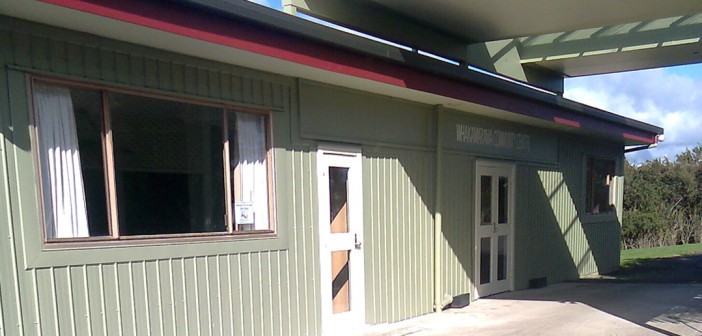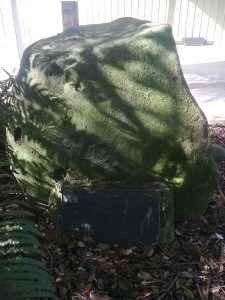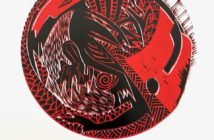Like a rural phoenix the Whakamarama Hall is rising from the ashes of declining use and rural and lifestyle social lethargy enthused by the contemporary efforts of community and sustainability minded individuals.
It’s late one very early autumn afternoon when I creep into my district Hall and sit behind the servery bench of the Hall kitchen. They had a wonderfully diverse pot luck lunch and I have to control myself not to pick up a piece of really yummy looking cake.
In the cavernous body of the Hall there’s a large, seated circle: some of them have blankets over their knees and they’re all “wrapped up warm” – it’s decided to be cold and wet outside. There’s a mature man with a grey pony tail encouraging a group of soprano-voiced women to sing phrases from “Cotton Fields” over and over again. What I wonder is this?
I’ve come to the Saturday of a weekend music and singing workshop organised in the Whakamarama District Hall/Community Centre. It’s been a long day by the time I show up in the kitchen– the backs of the men are slumped. They have an air of controlled boredom. The musical director turns and approaches the clump of seated men “he has a special part for them” – they visibly perk up. He goes round the circle (which is grouped in voice categories) and they all sing the same bit in their own particular pitch – it’s a bit like we did in school singing and assembly. They all seem to be Pakeha (except for one long-term resident). Then it’s two rounds of heartily sung “Cotton Fields” Grey ponytail tells them they’re almost out of time unless they stay on an extra half an hour: an emphatic “no” from an older gentleman whom I’ve seen helped to his feet on occasions, puts a stop to that.
While the packing up starts I talk to tutor Max of Sing For Joy– he’s been invited down from Auckland by local friends. Yes, he does this professionally now and has abandoned his former career. He’s the musical director of a ukulele orchestra in Auckland. Yes, he goes all over the place doing it and yes, tomorrow’s the ukulele workshop. Back in the kitchen I find tired but happy people reclaiming plates and pots. Yes, they loved it. No it’s not the first singing/musical workshop they’ve been too. Wouldn’t a local choir be great?
I’m not sure I would have fitted into the day-long “proper” workshop. “Takes all sorts” is probably what the hall singers would think about me. It was just expected that I would learn the piano. Some of my happiest and strongest childhood memories are of my Mother sitting belting out all sorts of music while I danced and sang. I remember the hours spent singing along to “pop” songs on my “transistor” and singing guitar-accompanied contemporary and traditional English and Maori “songs” with what was then called “The University Maori Club.” But the one thing the Whakamarama Hall Sing For Joy workshop participants and I have in common is, we love to sing!
Some weeks after the Whakamarama weekend musical workshop I’m at the Bethlehem Pottery Exhibition; I run into one of my neighbours who is showing her work in that exhibition. She mentions how good the Sing For Joy workshop was and how much she enjoyed it. I tell her that I’m more than pleased to see our district hall phoenix-like coming alive again.
The delightful tutor Max can be contacted by email at Max@SingForJoy.org.nz or you can Phone him on 027 264 4240 Max has two websites:www.singforjoy.org.nz and www.HandPickedUkes.co.nz
HISTORY OF THE WHAKAMARAMA HALL/COMMUNITY CENTRE
This report was submitted by the History Group of Whakamarama Community Inc and was published in Issue 6 Summer 2015, 16 Roads, Whakamarama News & Directory.
“On June 9th 1974, ninety-two year old Te Tawa Williams was only half way through the blessing of the Whakamarama hall site ceremony when the heavens opened. Many of those present have vivid memories of a man standing undaunted in the rain, refusing even the shelter of an umbrella.
To commemorate the occasion a stone, which came from a river near Katikati, had been placed on the hall site. The plaque on the front reads: “This hall stands on land given to the district by the Bidois family of the Piri Rakau. The site was blessed by Te Tawa Williams at a ceremony here on 9th June 1974. The ceremony culminated in speeches in a marquee at the school and a hangi organised by Nai Moanoroa and the Whakamarama Social Club.
“The building of a hall in Whakamarama was the culmination of a number of ideas and events. These were
(a) Provision of financial support from the Clive Foster Estate
(b) The gift of the land by Peter Bidois and his family
© The work done by local residents in actually building, painting and furnishing the
hall
(d) The idea of a hall had been discussed at many district functions and eventually a
committee was set up. This committee delegated responsibilities to sub-groups to investigate aspects of the project and to report back to the district. One requirement for the hall was a room for meetings and also the country library books.
Plans were drawn up but some time lapsed as the Tauranga Country Council (Now WBOPDC) were unhappy with the budget, given a significant proportion of the potential cost was negated by local volunteer labour, and Buster Frentz donating the tawa for the floor milled from his farm.
Construction of the service block started in the middle of 1974. Volunteers were drawn up into teams, which were rostered on for three days at a time. Work progressed smoothly and stage one was nearly finished by the end of July.
On August 7 1974, the following letter was received from the County Council: “Council was pleased to receive a staff report on the excellent progress made in the construction of stage 1 of the hall and more particularly with the excellent results achieved in keeping well within the budget by the use of so much voluntary labour.”
Approval was given for Stage 2, which started in March 1975 and construction was completed by May, thanks to an enormous mobilisation and co-ordination of local volunteer labour.
The whole project was completed for just under $30,000. It was funded primarily with support from the Clive Foster Memorial Fund, Tauranga County Council and Golden Kiwi, along with the generous donation of the land by the Bidois family.
Mr Leo Schultz MP declared the hall open on 25th July 1975 at a dinner and dance organised by the social committee and attended by 180 people.”
Take a look at facebook.com/sixteenroads And read the article about the Sustainable Village Network (see below) Despite the often advertised real estate “Whakamarama” tagline there are only sixteen roads in the Whakamarama District and they’re listed on the front of the regularly produced 16 Roads, Whakamarama News & Directory. I’ve been in Whakamarama just long enough to find out the first layer of local history: it’s not always what’s written in the history books and it’s not always been told to me by the writers of the “official” accounts. The word “serendipitous” often appears in my articles and that’s how I met the late Mrs Atiria Ake of Te Puna with family links to Whakamarama. Some years ago, we were both making submissions to the Western Bay of Plenty District Council. Mrs Ake was asking Council to return the land which had been the historical pa site to which she was connected. Mrs Ake and I drove home together and she told me about the Bidois family giving land for the Hall. If I remember correctly she also told me Pirirakau donated the land for the Whakamarama School. She told me about the stone and the plaque outside the hall. I went to have a look I found them overgrown in front of the Hall door.
WHAKAMARAMA DISTRICT
The Whakamarama District is a wonderful rural area on the ever encroaching outskirts of urban Tauranga. Part of the wider Western Bay of Plenty District, Whakamarama is a plateau and is steeped in the history and early development of Tauranga, the Bay of Plenty and New Zealand. Upper Whakamarama is a natural gateway to the Kaimai Mamaku Ranges and is home to the Puketoki Reserve, a remnant of the indigenous forest cover of the area.
Whakamarama, particularly Upper Whakamarama, retains the character and ambiance of traditional rural New Zealand. Despite the development of more intensive horticulture on the climatically suitable lower areas and the creation of lifestyle property lots (with diverse and interesting land uses) Whakamarama remains home to working dairy, sheep, and sheep and beef farms. It’s a place where you can still drive past stock trucks, little trailers of sheep or calves, articulated milk tankers, large trucks hauling up the hill to collect produce for local and international markets, truck loads of kiwifruit and avocado bins for the lower slopes and meet tractors round the corner. Combined with the wonderful rolling nature of much of the land, many properties have panoramic views and the numerous areas of residual native forest and foliage, Whakamarama provides a wonderful canvas for those seeking a rurally based lifestyle close to Tauranga but within easy driving distance of Katikati.
The Whakamarama Corner is home to the Village Store which stocks an eclectic range of products and consumables and now houses the local Lotto outlet. There’s a fresh fish and fish and chip shop. On the adjacent site is a barber, agricultural sales centre and a garage. The Gull petrol station is a traveller drawcard.
Lava East Restaurant complex is “over the road” on the corner of SH2 & Plummer’s Point, there’s a garden afternoon tea business on the Old Highway. 10 minutes away you’ll find the urbanised seaside settlement of Omokoroa (a designated growth area) with its inner Harbour Beach, cafes and children’s playground. There’s also a Western Bay of Plenty District Council Service Centre and Library.
The District of Whakamarama is now just 10 minutes north of the stylish Bethlehem Town Centre with its large supermarket, variety of shops, cafes, diverse professional services, a Post Office and Kiwibank. Bethlehem is also home to Somerset Cottage (an iconic Tauranga restaurant) a large Palmer’s Garden Centre with its Cafe Botannix, the décor Garden Centre with its Eden Cafe and gift shop. The Bethlehem Pottery Club has its facilities and gallery opposite Palmer’s.
The Tauranga CBD is about 17 minutes drive from Whakamarama. You’ll find cinemas, the Baycourt Arts and Community Centre, Tauranga City Council offices, the Tauranga Public Library, the Tauranga Art Gallery, the Community Gallery of Creative Tauranga. The Elms is a collection of buildings and artefacts relevant to the very early years of European settlement in Tauranga. On the waterfront are remnants of previous times as buildings such as No 1 The Strand and The Cargo Shed on Dive Crescent find new uses as a media centre and an art and art craft centre. In this section of town you’ll also find the Whare Waka – the Canoe Shed/House covering and protecting an example of a Maori canoe. In the inner suburbs you’ll find the Historic Village on 17th Avenue, the Gate Pa-Pukehinahina historic land wars battle site.
On the way to the Bethlehem Town Centre and the Tauranga CBD you pass through the developing area of Te Puna – award winning “Nourish” cafe and Bostock’s Butchery (the former iconic Whaka Meats), the creative complex at Village 7 with Cafe Paradiso renowned for its gigantic yorkshire puddings.
Whakamarama has a diversity of lifestyle property sizes and dwelling construction – modest cottages to newer, contemporary and award-winning properties of significant materials and proportions. Some are home to B & B’s or home based businesses with roadside signs. The main road has been widened and curbed in parts but one or two gravel roads remain providing their residents with a real old-fashioned New Zealand rural experience while having almost instant access to the surrounding urban facilities.
Whakamarama School in Upper Whakamarama, opposite the District Hall, is the focus of some interesting community activities – the best known being the annual “Possum Hunt” – a fund day with a serious ecological purpose. School buses collect children for Whakamarama School (which can take children through until they go to secondary school) and the District is dotted with corrugated iron bus shelters. Some Whakamarama children go down to school at the Omokoroa No 1 School or through to junior classes at Bethlehem College. School buses also collect children for various secondary schools.
A strong sustainable lifestyle theme is developing within the District with the Whakamarama Hall becoming a focus for village and community activities. The District has its own e network run on a voluntary basis by the inimitable Colin Hewens. There’s a steady stream of messages to the inbox offering excess produce for sale, sharing plants, seeking paid work, letting you know of property for rent. There are also notices about “strangers” and unwanted activities within the area and wandering stock. Don’t laugh at this last one – think cow, think horse, think small modern car and you’ll know who’ll come off second best in any contest of contact – it’s not the stock. Based at the Hall are the monthly Thank Whaka It’s Friday social evenings. There are Harvest and Mid Winter Festivals. When I arrived in Tauranga I was told Whakamarama means “the place of enlightenment.” Many of its residents would agree.
16 Roads Whakamarama News & Director Issue 6 Summer 2015 contains a lengthy article by “Debbie” “Sustainable Villages Network” an account of visitor Tom Vellinga from the Netherlands who is the Co-ordinator of The Sustainable Villages Network
Take a look at http://netwerkduurzamedorpen.nl/ CLICK ON THE UNION JACK AT THE TOP FOR THE ENGLISH TRANSLATION
Rosemary Balu. Rosemary is the founding and current Editor of ARTbop the online arts magazine for the Bay of Plenty.







